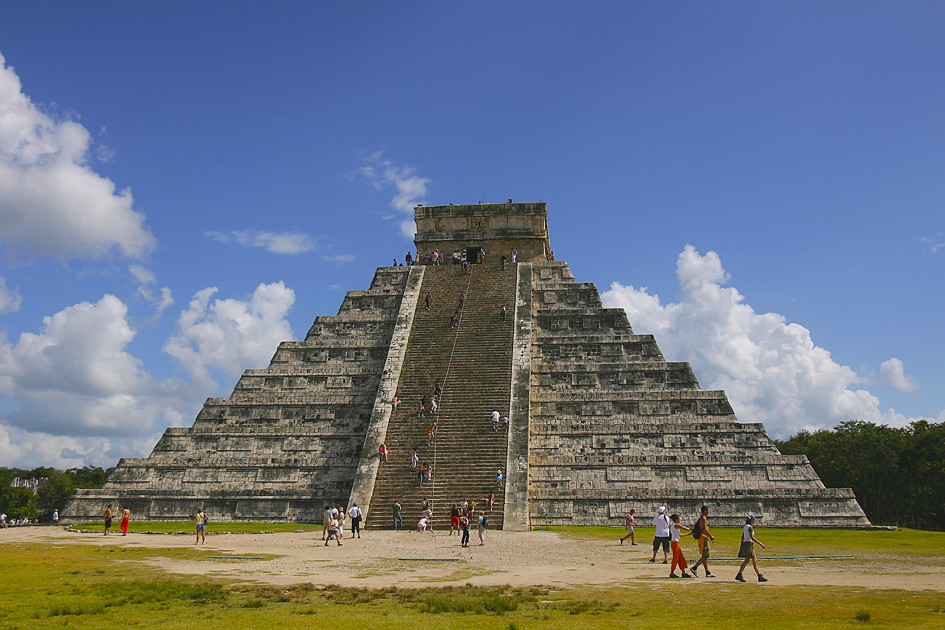Chichen Itza History
Known as one of the main archaeological sites of the Yucatan Peninsula; the history of Chichen Itza dates back several centuries, incredible mysteries and a lot of culture, learn with us a little more about it.
Chichen Itza’s History
According to chronicles, it is estimated that Chichén Itzá was founded during the small eastern descent of the Chanes from Bacalar, around 250 A.D. approximately.
After the Chanes established themselves and formed their government in Chichén Itzá, they continued their journey through the Yucatán peninsula, founding other important cities such as: Ek Balam, Motul, Izmal and T’hó, and which today we know as Mérida, Yucatán and Champotón.
Towards the end of the Late Classic period and during the first years of the Postclassic period; between 900 A.D. and 1500 A.D., Chichén Itzá became one of the most important political centers in the lands of the Mayab; and the main source of power within the Yucatán peninsula.

Evolution of Chichén Itzá
Yucatan was the main seat of the League of Mayapan, which was the union of the priestly houses of the entire Yucatan peninsula, among which was the powerful Chichen Itza, along with Uxmal and Mayapan. It is worth mentioning that when Chichén Itzá was founded by the Mayas coming from the east, they were looking for peace and development for all their people, thus settling in the Mayab. But 1,000 years later, the entire region became a place of combat and offensives.
In the year 1194 A.D., one of the greatest acts of violence of the place was born; which took place after the declaration of war between the caciques, motivated by a strong disagreement. This brought as a consequence the rupture with the Itzáe, who had to flee and take refuge in the old Petén, where they originally came from; because they lost the conflict.
Before the overthrow, impressive constructions had already been formed in the place; the merchants, warriors and priests who governed the place, introduced the people to the worship of the god Kukulçán. However, these constructions were nothing more than slopes, vertical walls and some representations of the bird-serpent god.

During the decadence, the main foundation in Maya culture was militarism; this can be seen in the monument called Platform of the Skulls, which can still be seen today. Although the name of this monument already tells us a lot; its history tells that, in this place, the warriors exhibited the skulls of the enemies annihilated in battle, which were later nailed to stakes.
Chichén Itzá managed to preserve its fame as a sacred place during the conquest; for this reason, Mayan pilgrims still went to the ancient capital of the Itzáes to perform rituals in the Sacred Cenote, in the main castle and in the Ossuary.
Importance of Chichén Itzá
According to the history of Chichén Itzá, this place had obtained great importance thanks to its impressive dimensions; also, because in spite of the centuries that had passed, the objects in its interior were still very well preserved.
Its importance was so great that Francisco de Montejo proposed to establish in this place the capital of the province of Yucatan; of course, it goes without saying that the idea did not bear any fruit.
In Chichén Itzá, the sacred cenote is one of the most important places of pilgrimage in the Mayan culture. This incredible cenote is located in the open air, with 60 meters in diameter and vertical walls; at least 15 meters high up to the water surface and 13 meters deep.

Human sacrifices at Chichén Itzá
Initially, the idea was created that the sacrifices in the sacred cenote were of maidens; however, it was recently revealed that these human sacrifices were actually mostly of children. These children, between 8 and 12 years of age, were adorned as the image of the twin gods and were eventually sacrificed in ceremonies tied to the Maya myth of creation.
First explorations at Chichén Itzá
After the history of Chichén Itzá developed, the first visits by Europeans began in the 16th century; the first to arrive were the Spanish conquistador Francisco de Montejo and the Franciscan Diego de Landa.
Since then, many people have come to visit Chichén Itzá, discover artifacts and conduct explorations; such was the case of John Lloyd Stephens and Frederick Catherwood in 1840. In 1894, it was Edward Herbert Thompson who acquired the Hacienda de Chichén Itzá to conduct studies in the area, allowing many more people to explore it.
Conclusion
Chichen itza is one of the mystical places you have to visit on your vacation to the Riviera Maya, so schedule between your days of visit, this incredible and fantastic place. Still don’t know how to get there? Don’t worry and book your transfer to Chichen itza right now.

